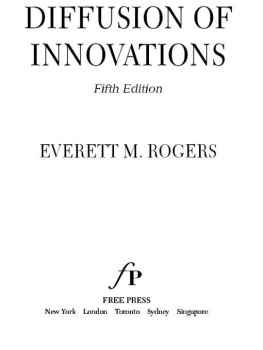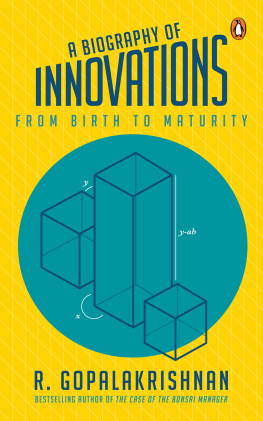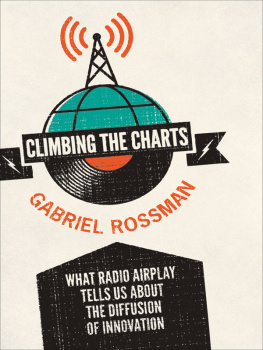Copyright 1995, 2003 by Everett M. Rogers
Copyright 1962, 1971, 1983 by The Free Press, A Division of Simon & Schuster, Inc.
The first edition of this book, by Everett M. Rogers, was published as Diffusion of Innovations; the second edition, by Everett M. Rogers with F. Floyd Shoemaker, was published as Communication of Innovations: A Cross-Cultural Approach; the third edition, by Everett M. Rogers, was published as Diffusion of Innovations, as was the fourth edition.
Library of Congress Cataloging-in-Publication Data Rogers, Everett M.
Diffusion of innovations / Everett M. Rogers5th ed.
p. cm.
1. Diffusion of innovations. 2. Diffusion of innovationsStudy and teachingHistory. I. Title.
http://www. SimonSays.com
Contents
Preface
Chapter 1: Elements of Diffusion
Water Boiling in a Peruvian Village: Diffusion That Failed
What Is Diffusion?
Controlling Scurvy in the British Navy
Nondiffusion of the Dvorak Keyboard
Four Main Elements in the Diffusion of Innovations
1. The Innovation
2. Communication Channels
3. Time
4. A Social System
Diffusion of Hybrid Corn in Iowa
Summary
Chapter 2: A History of Diffusion Research
The Beginnings of Diffusion Research in Europe
Gabriel Tarde and Imitation
Georg Simmels Stranger
The British and German-Austrian Diffusionists
The Rise of Diffusion Research Traditions
Paradigms and Invisible Colleges
The Anthropology Research Tradition
Miracle Rice in Bali: the Goddess and the Computer
Early Sociology
Rural Sociology
The Diffusion of Modern Math in Pittsburgh
Worldwide Diffusion of the Kindergarten
Public Health and Medical Sociology
The Columbia University Drug Diffusion Study
The Taichung Field Experiment
STOP AIDS in San Francisco
Communication
Diffusion of News of the September 11 Terrorist Attacks
Marketing
Opinion Leaders and Mavens in the Diffusion of Electric Cars
Geography
General Sociology
Networks in Recruitment to Freedom Summer
Trends by Diffusion Research Traditions
A Typology of Diffusion Research
Summary
Chapter 3: Contributions and Criticisms of Diffusion Research
The Status of Diffusion Research Today
Criticisms of Diffusion Research
The Pro-Innovation Bias of Diffusion Research
Pure Drinking Water in Egyptian Villages
Preference for Sons in India and China
The Individual-Blame Bias in Diffusion Research
The Recall Problem in Diffusion Research
The Issue of Equality in the Diffusion of Innovations
Summary
Chapter 4: the Generation of Innovations
The Innovation-Development Process
1. Recognizing a Problem or Need
2. Basic and Applied Research
Birth of the Laptop Computer at Toshiba
3. Development
How the Refrigerator Got Its Hum
Classifying the Segway
4. Commercialization
Fumbling the Future at Xerox PARC
5. Diffusion and Adoption
6. Consequences
Serendipity in the Discovery of Warfarin
Socioeconomic Status, Equality, and Innovation Development
Hard Tomatoes in California
Tracing the Innovation-Development Process
The Shortcomings of Tracer Studies
Future Research on the Innovation-Development Process
The Agricultural Extension Model
Summary
Chapter 5: The Innovation-Decision Process
A Model of the Innovation-Decision Process
The Knowledge Stage
Which Comes First, Needs or Awareness of an Innovation?
Three Types of Knowledge About an Innovation
Early Versus Late Knowers of Innovations
The Persuasion Stage
The Decision Stage
The Implementation Stage
Re-Invention
How Much Re-Invention Occurs?
Re-Invention Is Not Necessarily Bad
Why Does Re-Invention Occur?
Re-Invention of Horse Culture by the Plains Indians
The Confirmation Stage
Dissonance
Discontinuance
The Discontinuance of Smoking
Forced Discontinuance and the Rise of Organic Farming
Are There Stages in the Innovation-Decision Process?
Process Versus Variance Research
Evidence of Stages
The Hierarchy-of-Effects
Stages-of-Change
Communication Channels in the Innovation-Decision Process for Tetracycline
Communication Channels by Stages in the Innovation-Decision Process
Categorizing Communication Channels
Mass Media Versus Interpersonal Channels
Cosmopolite Versus Localite Channels
The Bass Forecasting Model
Communication Channels by Adopter Categories
The Innovation-Decision Period
The Rate of Awareness-Knowledge and Rate of Adoption
The Length of the Innovation-Decision Period by Adopter Category
How the Internet Is Changing the Innovation-Decision Process
Summary
Chapter 6: Attributes of Innovations and Their Rate of Adoption
Black Music in White America: Rap
Rate of Adoption
Research on the Attributes of Innovations
Measuring the Attributes of Innovations
Organizations as the Units of Adoption
Postdiction Versus Prediction
An Agricultural Innovation That Failed
Relative Advantage
Economic Factors and Rate of Adoption
Status Aspects of Innovations
Overadoption
Relative Advantage and Rate of Adoption
Preventive Innovations
The Effects of Incentives
Mandates for Adoption
Compatibility
Compatibility with Values and Beliefs
Compatibility with Previously Introduced Ideas
Compatibility with Needs
Photovoltaics on a Million Roofs
The Daughter-in-Law Who Doesnt Speak
Compatibility and Rate of Adoption
Technology Clusters
Naming an Innovation
Positioning an Innovation
Acceptability Research
Indigenous Knowledge Systems
Complexity
Trialability
Observability
Cellular Telephones and the Lifestyle Revolution
Summary
Chapter 7: Innovativeness and Adopter Categories
Diffusion of Farm Innovations in a Colombian Village in the Andes
Classifying Adopter Categories on the Basis of Innovativeness
The S-Shaped Curve of Adoption and Normality
Measuring Organizational Innovativeness
Who Adopts?
Adopter Categorization
Adopter Categories as Ideal Types













